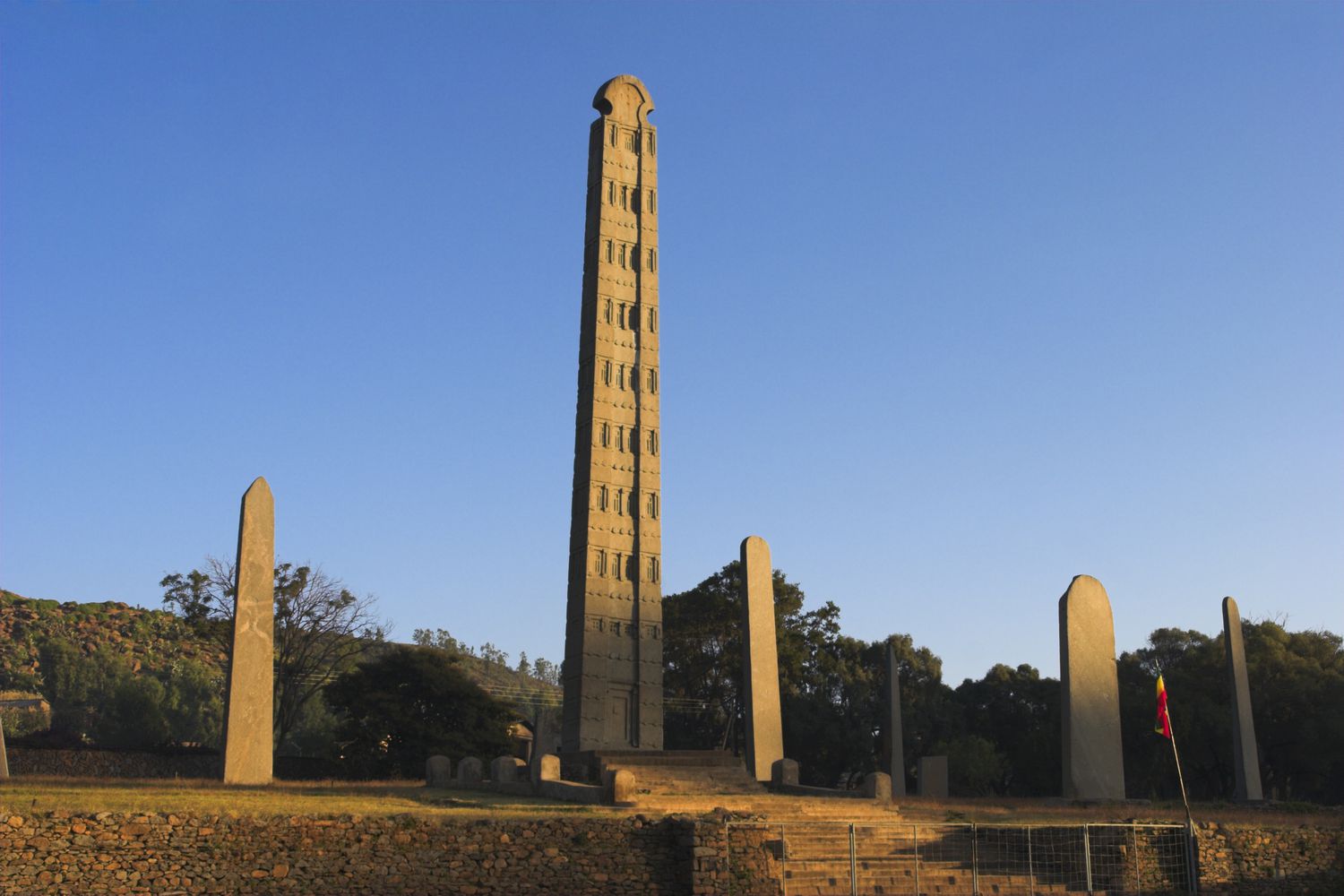Introduction
Aksum, an ancient kingdom located in modern-day Ethiopia, flourished as a prominent trading center from the first to the eighth century CE. Situated in the eastern part of Africa, Aksum’s strategic geographic location, along with its well-established trade routes and abundant resources, propelled it to become a vital hub for commerce in the ancient world.
Aksum’s rise as a trading center can be attributed to various factors, including its geographic position, which facilitated extensive interactions with neighboring regions. Additionally, the kingdom’s wealth of valuable resources, its adoption of a sophisticated currency system, its close ties with the Arabian Peninsula, and its strategic military location all contributed to its significance as a bustling trading hub.
Throughout history, Aksum’s economic prosperity was closely intertwined with its trading opportunities. The kingdom’s advantageous location allowed it to serve as a bridge between Africa, Asia, and Europe, facilitating the exchange of goods, ideas, and cultures across long distances.
Fostered by its geographical advantage, Aksum established a vast network of trade routes that extended from the Red Sea coast to the interior of Africa, ensuring a steady flow of commodities. These routes connected Aksum to major trading centers such as Egypt, Persia, India, and the Mediterranean, providing access to coveted goods like spices, precious metals, silk, ivory, and exotic animals.
Profitable resources indigenous to Aksum further fueled its economic growth. The kingdom boasted fertile lands ideal for agriculture, yielding various crops such as grains, fruits, and vegetables. It was renowned for its production of high-quality cotton, which played a vital role in the textile industry. Aksum was also rich in minerals, particularly gold and salt, which were highly desired commodities in the ancient world.
To facilitate trade and promote economic stability, Aksum adopted its own currency system. The kingdom minted its own coins, which became widely accepted within its trading network and beyond. This standardized currency enhanced commercial transactions, providing a sense of security and eliminating the need for bartering. The Aksumite coins, made primarily of gold, silver, and bronze, were intricately designed, displaying the kingdom’s wealth and sophistication.
Geographic Location
The geographic location of Aksum played a crucial role in its emergence as an important trading center. Situated in the Horn of Africa, the kingdom enjoyed proximity to major maritime routes, making it an ideal gateway for commercial activities between Africa, Asia, and Europe.
Aksum’s strategic position along the Red Sea coast allowed it to connect with maritime traders sailing from the Arabian Peninsula, Egypt, and the Mediterranean. Its port cities, such as Adulis and Adulis Harook, served as crucial entry points for goods entering and exiting the kingdom. The location provided easy access to both the interior of Africa and the international trade network.
Moreover, the region’s topography favored agricultural development, enabling the kingdom to generate surplus agricultural products. The combination of fertile soil, suitable climate, and well-distributed rainfall facilitated the cultivation of diverse crops, including barley, wheat, teff, and millet. These agricultural resources not only sustained the local population but also became valuable commodities for trade.
The Red Sea coast was also rich in marine resources. The abundance of fish and other marine life added to the kingdom’s resource base and provided additional trading opportunities. The strategic location of Aksum ensured that it could tap into the wealth of both land and sea resources, enhancing its economic prospects.
Furthermore, Aksum’s location at the crossroads of different civilizations and cultures allowed for the exchange of ideas, knowledge, and innovation. Merchants and travelers passing through the region brought with them diverse customs, languages, and technologies, contributing to the cultural diversity and intellectual growth of the kingdom.
In summary, the geographic location of Aksum provided it with a unique advantage in the ancient world. Its proximity to major trade routes, fertile agricultural lands, access to marine resources, and role as a cultural melting pot positioned it as a key trading center. These geographical factors, combined with the kingdom’s resources and infrastructure, laid the foundation for Aksum’s prosperous trade-based economy.
Trade Routes
Aksum’s prominence as a trading center can be attributed to its extensive network of trade routes that spanned across Africa, Asia, and Europe. The kingdom’s strategic location at the junction of major land and maritime routes made it a crucial hub for the exchange of goods, ideas, and cultures.
One of the most significant trade routes that Aksum benefited from was the Red Sea trade route. Connected to the Arabian Peninsula, this maritime route facilitated the exchange of goods between Aksum and prominent trading centers such as Yemen and the Roman Empire. Ships loaded with valuable commodities like spices, incense, and precious metals made their way to Aksum’s ports, fortifying the kingdom’s economic prosperity.
Aksum also found itself at the crossroads of the Trans-Saharan trade routes, which linked North Africa to the western and central parts of the continent. This facilitated the exchange of goods between Aksum and regions such as Egypt, Sudan, and West Africa. Aksum served as a vital intermediary between North Africa’s Mediterranean coast and the vast interior of Africa, allowing for the transference of goods like copper, salt, textiles, and ivory.
Moreover, the trade routes extending to the Indian Ocean played a significant role in connecting Aksum to the powerful trading economies of India and Southeast Asia. Aksum established a close trading relationship with the kingdom of Axum in modern-day Yemen, which acted as a vital intermediary for further trade connections with India and the Far East. This maritime trade network allowed for the exchange of items such as spices, silk, pearls, and precious gems, enriching Aksum’s commercial ventures.
The trade routes that converged upon Aksum made the kingdom a melting pot of diverse cultures and peoples. Merchants and travelers from different regions brought with them their languages, customs, and traditions, contributing to the vibrant multicultural fabric of the city. This multicultural exchange fostered innovation, facilitated the spread of new ideas, and enhanced the commercial opportunities available in Aksum.
Overall, the elaborate trade routes connecting Aksum to various regions allowed for the flow of valuable goods and fostered cultural exchange. This network enabled Aksum to establish itself as a dominant trading center, facilitating economic growth and solidifying its position in the ancient world.
Resources
Aksum’s wealth and prominence as a trading center were greatly influenced by the abundance of valuable resources within its territory. The kingdom’s rich assortment of natural resources played a vital role in its economic growth and positioned it as a lucrative trading hub in the ancient world.
One of the key resources that bolstered Aksum’s economy was its fertile agricultural land. This allowed the kingdom to cultivate a variety of crops, including grains such as barley and wheat, as well as teff, a nutritious grain still widely consumed in Ethiopia today. The agricultural surplus generated by Aksum’s productive lands not only ensured food security for its population but also provided commodities that could be traded with neighboring regions.
Aksum was also acclaimed for its cotton production, which thrived in the kingdom’s ideal climate and soil conditions. The high-quality cotton fibers were in high demand in the textile industry, both domestically and in international trade. Aksum’s cotton production not only met local demands but also became a valuable export commodity that contributed to the kingdom’s economic prosperity.
In addition to agriculture, Aksum possessed significant mineral resources, most notably gold and salt. Gold, often referred to as “the king of metals,” was highly valued globally for its scarcity and beauty. Aksum’s gold mines, located in the southwestern part of the kingdom, became a source of immense wealth and attracted traders from far-flung regions. The acquisition and trade of gold not only enriched the kingdom’s coffers but also solidified its status as a wealthy and influential trading center.
Salt, another valuable resource found within Aksum’s territory, was a precious commodity essential for preserving food and enhancing flavor. Aksum controlled salt mines in the Danakil Depression, located in present-day Eritrea and Ethiopia. The kingdom’s dominance over these salt deposits gave it a significant advantage in regional and long-distance trade, as salt was a critical ingredient and highly sought-after commodity across various civilizations.
The availability and exploitation of these abundant resources provided Aksum with a strong economic foundation. The kingdom’s ability to produce and trade agricultural goods, cotton, gold, and salt allowed it to accumulate wealth, attract merchants from distant lands, and thrive as a significant trading center in the ancient world.
Aksumite Currency
Aksum’s adoption of a sophisticated and standardized currency system played a crucial role in its development as a prominent trading center. The kingdom minted its own coins, which became widely accepted within its trading network and beyond, solidifying Aksum’s economic stability and facilitating commercial transactions.
Aksumite currency consisted primarily of gold, silver, and bronze coins, each with its own value and purpose. The coins were intricately designed, displaying the kingdom’s wealth and artistic finesse. The most common denomination was the gold dinar, followed by the silver sela and the bronze coin, which was known as the bronze follis.
The Aksumite currency system provided various benefits that contributed to the kingdom’s economic prosperity. First and foremost, it provided a standardized medium of exchange, eliminating the need for bartering and creating a sense of trust and security in commercial transactions. Merchants and traders could easily calculate the value of goods based on the relative worth of the coins, enabling efficient trade within Aksum and with other regions.
Furthermore, the minting of coins empowered the Aksumite rulers, as it allowed them to assert their authority and affirm their position as leaders. The coins were adorned with portraits and inscriptions, often featuring the reigning monarch’s image, emphasizing their power and legitimacy.
The widespread acceptance of Aksumite coins and their value outside of the kingdom’s borders enhanced Aksum’s trading relationships with other regions. The coins were highly regarded by merchants and traders from neighboring lands, who recognized the stability and trustworthiness associated with Aksumite currency.
The currency system also facilitated the accumulation of wealth for Aksum. As trade flourished and the kingdom amassed valuable commodities, the coins became a tangible representation of its prosperity. The acquisition and control of precious metals, such as gold and silver, enabled the minting of coins and further consolidated Aksum’s economic influence.
Over time, Aksumite coins spread throughout various trade networks, reaching as far as the Arabian Peninsula, the Mediterranean, and even India. The circulation of coins outside of Aksum’s borders not only strengthened its ties with trading partners but also served as a means of promoting the kingdom’s reputation and prestige.
In summary, the adoption of a sophisticated currency system by Aksum played a pivotal role in its economic development and rise as a significant trading center. The minting of coins provided a reliable medium of exchange, established the authority of Aksum’s rulers, enhanced trading relationships, and solidified the kingdom’s economic influence both within its borders and beyond.
Aksum’s Relationship with the Arabian Peninsula
Aksum’s geographical proximity to the Arabian Peninsula fostered a strong and interconnected relationship between the kingdom and the Arabian traders. This relationship played a vital role in Aksum’s emergence as a prominent trading center, with significant cultural, economic, and political exchanges occurring between the two regions.
Trade between Aksum and the Arabian Peninsula was predominantly conducted through maritime routes, facilitated by the Red Sea. The Arabian Peninsula served as a crucial intermediary hub for trade between Aksum and other prosperous civilizations such as the Roman Empire and India. Arabian merchants, known as the Himyarites, played a pivotal role in facilitating this trade, acting as middlemen between Aksum and other regions.
The trade relationship between Aksum and the Arabian Peninsula was mutually beneficial. Aksum provided valuable commodities like ivory, gold, and agricultural products, while the Arabian traders brought coveted goods such as spices, incense, and luxury items like silk and fine textiles. This exchange of goods enriched both economies and contributed to the cultural diffusion between the two regions.
Aksum’s close ties with the Arabian Peninsula were not limited to economic relations. There were also significant cultural and religious interactions. The Arabian Peninsula was a melting pot of various cultures, and ideas and practices from the Arabian Peninsula influenced Aksum to a great extent.
One of the most notable cultural exchanges between Aksum and the Arabian Peninsula was the adoption of Christianity. In the 4th century CE, Aksum became one of the first kingdoms to embrace Christianity, which had already spread throughout the Arabian Peninsula. This religious transformation had a profound impact on Aksumite society, influencing its art, architecture, and governance and solidifying its identity as a Christian kingdom.
Aksum’s relationship with the Arabian Peninsula also had political implications. The kingdom maintained diplomatic ties with the Himyarite kingdom, which ruled parts of present-day Yemen. These diplomatic relations allowed Aksum to extend its influence and control over key trading routes, ensuring a steady flow of goods and reinforcing its position as a dominant trading center.
The decline of the Himyarite kingdom in the 6th century CE had a significant impact on Aksum. Political instability in the Arabian Peninsula disrupted the trade routes and weakened Aksum’s connections with other trading partners. This, coupled with other internal and external factors, contributed to the eventual decline of the Aksumite kingdom as a major trading power in the region.
In summary, Aksum’s relationship with the Arabian Peninsula was characterized by extensive trade, cultural exchanges, and political ties. The close proximity and maritime connections allowed for a flourishing trade network, fostering economic growth and cultural diffusion between the two regions. This interconnectedness played a crucial role in Aksum’s development as a prominent trading center and its influence in the ancient world.
Strategic Military Location
Aksum’s strategic military location significantly contributed to its importance as a trading center and played a crucial role in its ability to establish and maintain commercial dominance in the ancient world. Positioned in a region of strategic significance, Aksum benefited from various military advantages that solidified its position as a formidable power.
Aksum’s location in the eastern part of Africa served as a crossroads between different civilizations, making it a key focal point for trade routes and military expansions. Its proximity to the Red Sea allowed the kingdom to control crucial maritime routes, establishing dominance over the trade between Africa, Asia, and Europe. By asserting control over these trade routes, Aksum could regulate commerce, impose taxes, and safeguard its economic interests.
Furthermore, Aksum’s location in the Horn of Africa provided natural defenses against potential invaders. The rugged terrain of the region, including mountains and steep cliffs, created a formidable barrier that acted as a natural buffer, making it challenging for hostile forces to penetrate the kingdom’s territories. This natural protection allowed Aksum to maintain its independence and protect its interests against rival powers.
Aksum’s strategic military location also allowed for effective defense and control over critical resources. The kingdom’s control of vital resources such as fertile agricultural lands, gold mines, and salt deposits gave it a distinct advantage in sustaining its economy and military strength. Access to these resources ensured a stable food supply for its population and facilitated the accumulation of wealth, which, in turn, funded its military endeavors.
The strategic military location of Aksum also allowed the kingdom to project its power beyond its borders. With control over key trade routes, Aksumite forces were able to exert influence over neighboring regions and establish trade alliances with various kingdoms and empires. These alliances not only served to protect Aksum’s interests but also provided opportunities for expansion and increased diplomatic influence.
Aksum’s strategic military location also played a role in its ability to defend against external threats. The kingdom’s proximity to the Arabian Peninsula and the Red Sea allowed for close monitoring of potential rivals and maritime activities. It had the advantage of being able to respond swiftly to any incursions into its territories and protect its trade routes from piracy or hostile actions.
In summary, Aksum’s strategic military location provided numerous advantages that shaped its rise as a dominant trading center. Its position at the crossroads of key trade routes, its natural defenses, control over vital resources, and the ability to project power allowed Aksum to establish and maintain its commercial dominance and defend its interests in the ancient world.
Conclusion
The rise of Aksum as an important trading center can be attributed to a combination of geographic location, well-established trade routes, abundant resources, a sophisticated currency system, and its strategic military position.
Situated in the eastern part of Africa, Aksum’s strategic geographic location allowed it to serve as a vital bridge between Africa, Asia, and Europe. Its proximity to major trade routes, including the Red Sea and Trans-Saharan routes, facilitated extensive commercial interactions and the exchange of goods and ideas across long distances.
The abundant resources found within Aksum’s territories, such as fertile agricultural lands, cotton production, gold mines, and salt deposits, provided the kingdom with valuable commodities that fueled its economic growth and attracted traders from far-flung regions.
Aksum’s adoption of a sophisticated currency system, minting its own gold, silver, and bronze coins, established trust and economic stability, enhancing commercial transactions and solidifying its position as a prominent trading hub.
The kingdom’s close ties with the Arabian Peninsula, facilitated by maritime trade routes and cultural exchanges, further enriched its trading network and cemented its economic and political influence.
Aksum’s strategic military location, with its natural defenses, control of critical resources, and ability to project power, allowed the kingdom to protect its interests, assert dominance over trade routes, and defend against external threats.
In conclusion, the success of Aksum as an important trading center was not the result of a single factor, but rather a combination of geographical advantages, well-established trade routes, abundant resources, a sophisticated currency system, and strategic military positioning. All these elements contributed to Aksum’s economic prosperity, cultural diffusion, and political influence, establishing it as a prominent trading hub in the ancient world.

























